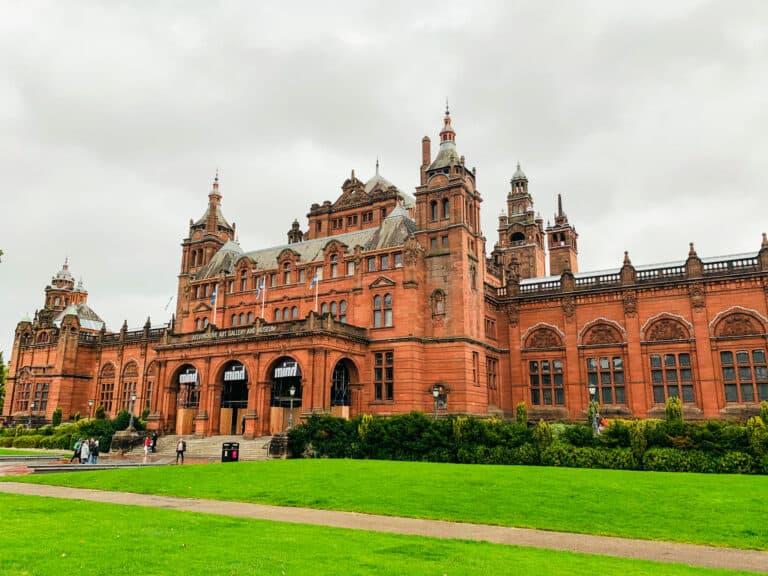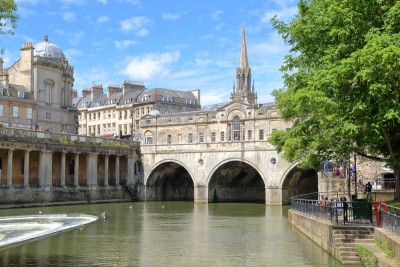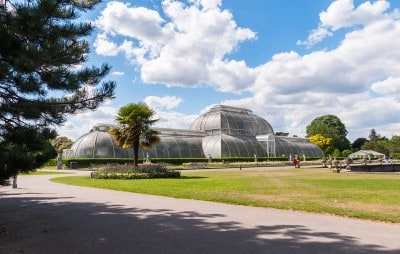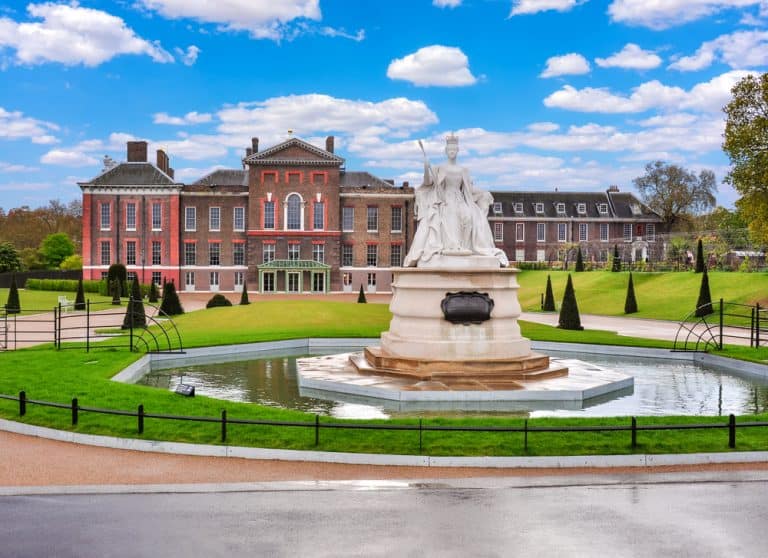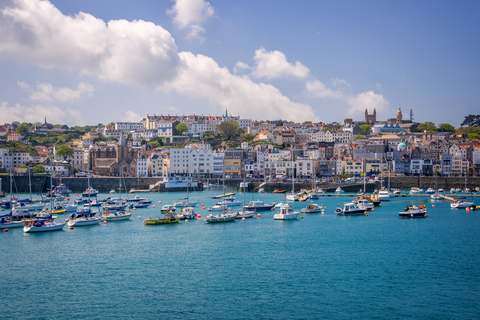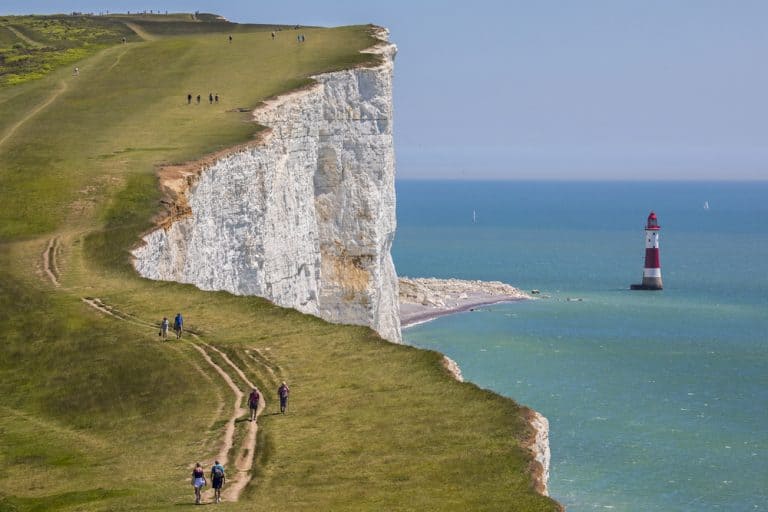Your guide to a day trip to Hampton Court Palace
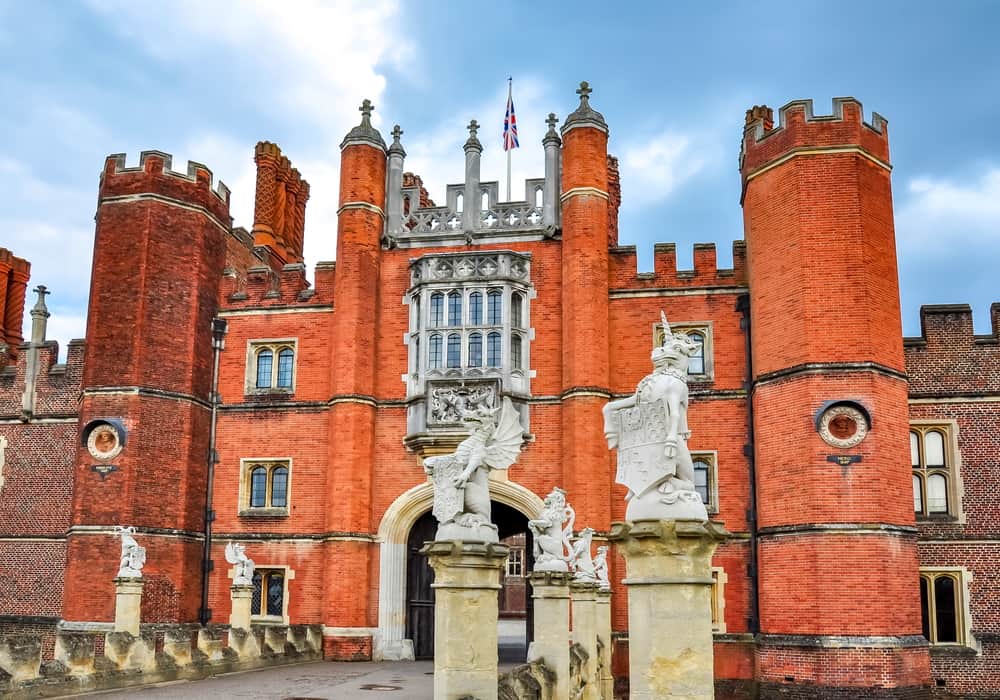
One of the most famous palaces in Britain, King Henry VIII’s sumptuous residence on the River Thames is an easy day trip from central London and a popular destination for history buffs and tourists alike.
This is your guide to a day trip to Hampton Court Palace in London
By Emma Marshall and Nick Warburton
This post contains affiliate links
Why visit Hampton Court Palace?
If you’re visiting London, a day trip to Hampton Court Palace is a must. Only 35 minutes by train from London Waterloo, it’s a great day out for all ages.
You will discover fine architecture spanning different historical periods, elegant rooms filled with art treasures, beautiful courtyards, the UK’s oldest surviving hedge maze and the Royal Tennis Courts, all sitting in more than 60 acres of gardens.
Read on for more information on what to see at Hampton Court Palace.
The history of Hampton Court Palace

The palace has a long history that stretches over seven centuries.
The earliest sections are Tudor and date from the late 15th century. But it is Cardinal Thomas Wolsey who really laid the foundations for the palace’s future expansion after taking it over in 1514.
When Henry VIII removed Wolsey from the palace in 1529, the king spent lavishly to create sumptuous surroundings that were fit for his royal needs. This included expanding certain sections, including creating a bigger kitchen for serving large meals in the Great Hall.
Successive royals made minimal changes until William III (William of Orange) and Mary II’s reign from 1689-1702 when the palace was partially rebuilt at enormous cost.
Designed by Sir Christopher Wren, the architect behind St Paul’s Cathedral, the elegant baroque palace was constructed beside the original Tudor palace.
Future royals adapted existing rooms to their personal needs but no major building work took place in subsequent centuries.
It was Queen Victoria who first opened the palace to the general public, allowing paid visitors the opportunity to explore the fabulous surroundings.
What can you see at Hampton Court Palace?
Home to British royalty for nearly 500 years, Henry’s original red brick Tudor palace was partially rebuilt during the reign of William III in a baroque style. This unique mixture of architectural styles blend together beautifully.
Hampton Court Palace is surrounded by beautiful gardens and extensive parkland that are also open to the public.
Wandering around the royal palace grounds, there’s no shortage of delights, including the Great Vine, the stunning Privy Garden, the Royal Tennis Court and the maze.
Routes through the palace
As soon as you walk through the Trophy Gate (the entrance near Hampton Court Bridge) you are presented with a long gravelled avenue and the palace’s main entrance (the West Gate).
This is the starting point for most tourists, although you can also enter at the Lion Gate opposite the entrance to Bushy Park.

The palace and grounds are so large that tourists are advised to break their visit into tours of the different palace sections and the grounds (see sections below).
When I attended, the palace had only recently reopened after the COVID-19 lockdown so some areas were restricted to the public. In some cases, designated routes had been set out to accommodate smaller numbers and maintain social distancing.
However, as Henry VIII is the person most commonly associated with Hampton Court Palace (he was the first royal to own the stately home), it makes sense to start your tour with the Tudor king’s state apartments.
This is the route I took. Read on for more information.
You can also click here to download a Hampton Court Palace map.
Henry VIII’s State Apartments
As soon as you walk out from under the West Gate, you step into the spacious Base Court. Straight ahead is the entrance to Anne Boleyn’s Gateway.
Entry to Henry VIII’s State Apartments is up the staircase to the left. This takes you on a fascinating historical tour through the palace’s Tudor period and Henry’s life here with his six wives and children.
The largest room in Hampton Court Palace – and undoubtedly one of its main draws – is the Great Hall, which is where Henry VIII entertained guests at banquets.

The vast hall catered for around 450 people, who sat twice daily. You can get a sense of the huge quantities of food and drink consumed from reading the annotated table cloths on the long dining tables.

Dating back to the 1530s, the Great Hall is breathtaking in design and size. While some of the original features survive, the hall was significantly restored in the 1840s.
Look up and around you and marvel at the stunning hammer-beam roof and elaborate stained glass windows. The vast expanse is decorated from the floor to the ceiling with Henry VIII’s royal symbols and badges and the tapestries lining the walls are incredible.

After leaving the Great Hall, you enter the Horn Room, complete with its original Tudor oak steps leading down to the kitchens (see later). The walls are decorated with antlers and horns, which date from a later period in the palace’s history.

Next up, you arrive in the Great Watching Chamber, the first of the king’s state apartments, which is where guards stood to protect the king.
Despite some modernisation by Sir Christopher Wren, this room is really unique. The decorated ceiling and tapestries both date from Tudor times. However, the panelling, stained glass and fireplace are from much later.
Part of the processional route, the Haunted Gallery is named after Henry VIII’s fifth wife Catherine Howard who was the second (and last) to be beheaded. Apparently her ghost roams the long corridor (hence the name).

It is lined with beautiful tapestries and paintings. One noteworthy painting The Family of Henry VIII shows the king with his third wife Jane Seymour and children, the future Queen Elizabeth I, Princess Mary and Prince Edward.
The route leads to another highlight, the Chapel Royal, which the official guidebook says has been in continuous use since Henry VIII’s reign. Divided into the Royal Pew and Chapel, it’s one of the few rooms where you can’t take any photos.
The Chapel Royal contains a reproduction of Henry VIII’s crown. This is made of gold, silver, pearls and real gemstones. The original was destroyed in 1649 under Oliver Cromwell’s reign.
The Tudor kitchens
When I attended, you approached the Tudor Kitchens via an entrance on Base Court.
A short covered alley leads you to Master Carpenters Court where provisions once entered the extensive complex. The kitchens’ entrance is on the right at the far end.

Before you reach the main kitchen area, you pass the Boiling House. This is one of many smaller areas used for preparatory work or storage (others included the Confectory, Pastry and Spicery).
It was here that kitchen staff boiled large joints of beef and mutton in the boiling pot throughout the morning and afternoon. This reduced the time needed for roasting in the Great Kitchen.
To give tourists an idea of what it was like, there are replica food and utensils on show throughout the Tudor Kitchens section.

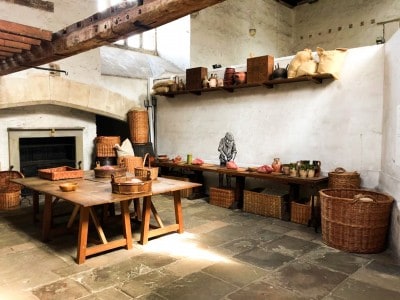
As you approach the Great Kitchen, you pass through Fish Court, a long narrow courtyard, which was apparently a hive of activity in the preparation of meals. The fish larder and pastry house were located here.
All of the Tudor kitchens were restored in the early 1990s to the way you will see them as you wander through the different sections. I found it all fascinating, but the highlight was definitely the Great Kitchen, which you enter from Fish Court.
Managed by Master Cook John Dale, this vast area was divided into three sections – the first kitchen, middle kitchen and third kitchen. This is where most of the food was assembled before being taken upstairs to the Great Hall.
The annotated posters on the walls and tables reveal some interesting facts.
For example, kitchen assistants known as turnbroches performed the arduous and exhausting task of turning the roasting spits. The work was not without its risks and servants often sustained burns or other injuries.
Of the three sections, the third kitchen is the oldest part and the most complete. The menu on the long table in this third section gives the visitor an indication of the sorts of food and drink that were consumed.


As you exit, you’ll notice two small rooms, which you can see through the hatches on the right.
Named ‘the Dressers’ because this is where dishes were dressed and garnished before being taken upstairs, administrators would check everything first to make sure the food met standards.
The Wolsey Rooms and Renaissance Picture Gallery
You can access the Wolsey Rooms and Renaissance Picture Gallery under the colonnade in Clock Court.
The former was the private lodgings of Hampton Court Palace’s original owner Cardinal Wolsey. Although later royals adapted the rooms to their own personal tastes, some original Tudor features survive.
You can also view two fascinating paintings. The first dates from around 1640 before William III rebuilt Hampton Court Palace and the second, an early 18th century painting, shows the completed south and east fronts.
The Renaissance Picture Gallery, as the name suggests, houses an impressive array of 16th and 17th century paintings.
The King’s Apartments
Built in the late 17th century by Sir Christopher Wren, the architect behind St Paul’s Cathedral, the King’s Apartments and the Queen’s State Apartments were the only parts of the original Hampton Court Palace to be rebuilt. They now form part of the impressive Baroque Palace section.
When William III and his wife Mary II came to the throne in 1689, the plan was to replace the entire Tudor structure with a modern palace that reflected the architectural styles of the period. However, a lack of money and time prevented them from fulfilling these ambitions.
Tragically, the King’s Apartments suffered from a major fire in the mid-1980s and what you see as you wander these magnificent rooms are painstaking restorations.
You start your tour in this section at the King’s Staircase. This is a vast open space with spectacular ceiling and wall decorations painted by Antonio Verrio.

From here you make your way through a succession of rooms. These include the Guard Chamber; the Privy Chamber (which looks out on to the Privy Garden); Withdrawing Room; the King’s Great and Little bedchambers; and Orangery.
One of the main highlights is the King’s Presence Chamber where you can see William III’s throne canopy.

The Queen’s State Apartments
Sir Christopher Wren was the architect who began the designs on the Queen’s State Apartments, which were completed after Queen Mary II’s death in 1694.
One of the main highlights is the Queen’s Drawing Room, which was commissioned by Queen Anne. This large spacious room features incredible decorations by Antonio Verrio, the same artist who painted the King’s Staircase.

The room also affords spectacular views from the central window of the East Front. From here, you can see the distinctive triangular yew trees in the Great Fountain Garden, the long avenues radiating out to Hampton Court Park and the large fountain.

The rest of the rooms – the Guard and Presence Chambers, the Public Dining Room and the Queen’s Private Apartments – were fitted out by George II and Queen Caroline during the Hanoverian (Georgian) period.
The Georgian Rooms
You access the Georgian Rooms from Clock Court. This takes you through the George II’s Gateway and up a small staircase.
There are some fascinating things to see here. The highlight for me was the Communication Gallery, a long corridor displaying portraits.

And then there’s the separate Cartoon Gallery which was built during William III’s reign. This was one of the first picture galleries in Britain where you can view copies of Raphael’s cartoons.
You can also see the Queen’s Private Oratory where Queen Caroline had prayers read to her. The stunning carved and moulded dome is beautiful.
Courtyards, cloisters and fronts
Adding to its incredible interiors, Hampton Court Palace boasts a number of spectacular courtyards, cloisters and fronts dating from different periods in the palace’s design.
From the Tudor period, you have Base Court, the first courtyard you enter from the West Gate. This is virtually unchanged since Cardinal Wolsey’s time. The odd structure in the middle is the wine fountain, which I read flows with real wine for special events.
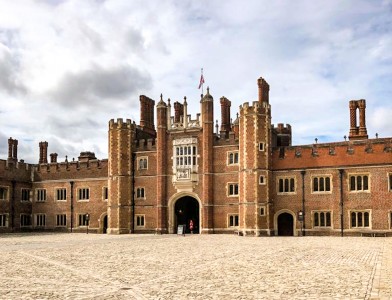

Arguably more impressive is Clock Court, originally the palace’s inner courtyard. Look up above the Anne Boleyn Gateway and you’ll see the palace’s famous 500-year-old astronomical clock.
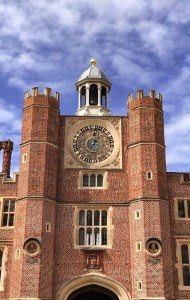
The colonnade on the south side of Clock Court dates from the late 17th century and reflects the different architectural style of the period.
Fountain Court, designed by Sir Christopher Wren, is arguably one of the highlights. Replacing an earlier courtyard built during Henry VIII’s reign, you can walk around the entire court through arched cloisters, marvelling at the central fountain.
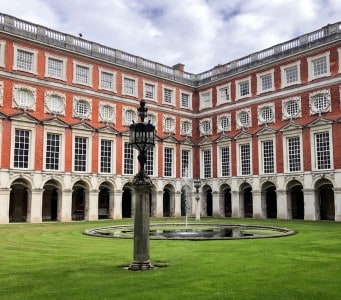
On the east side, you can walk out to the Great Fountain Garden and marvel at the architectural splendour of the East Front.
My guidebook stated that “Sir Christopher Wren’s design is probably the best expression of the Baroque style in England”. When you visit and see this, you’ll see it’s a masterpiece of design.
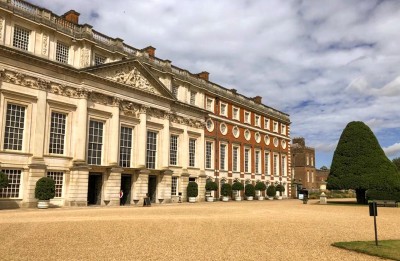
If you stand facing the East Front, you’ll notice a narrow gateway to your left that takes you through to the palace’s South Front.
The South Front is strikingly different to the Tudor Palace that you will see adjoining it at the far end. It’s also the perfect spot to explore the stunning Privy Garden.
The Palace gardens
You can explore more than 60 acres of gardens at Hampton Court Palace.
One of the main highlights is the Privy Garden, the king’s private gardens. Walk to the far end and look through the large ornamental ironwork screen and you can see the River Thames flowing past.
Look back and you will enjoy sweeping views of the South Front which houses the state apartments of William III.
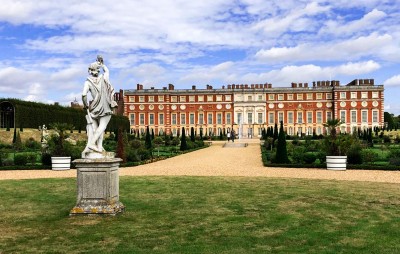
To the west of the Privy Garden, you’ll find several delightful, smaller gardens, notably Knot Garden and Pond Gardens.
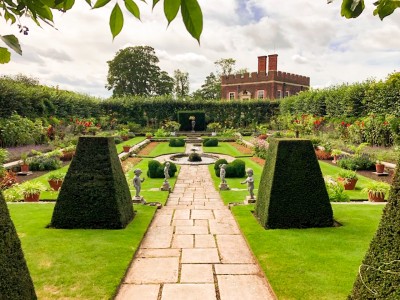
In this area, you’ll also see the Lower Orangery and the glasshouse containing the Great Vine, apparently the largest known vine in the world. It was closed when I visited but still produces grapes each year.

The area where the Great Fountain Garden stands was parkland during Henry VIII’s time but was later laid out as a grand semi-circle, complete with gravelled avenues and fountains. One of its most notable features is the triangular yew trees lining the avenues.
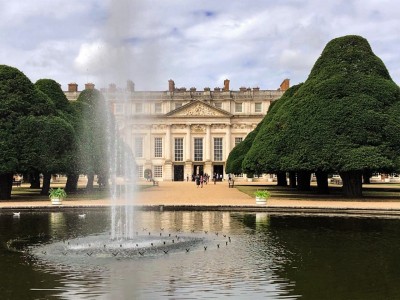
If you walk away from the East Front along the central avenue (and around the large fountain), you’ll come to Home Park, notable for its great canal (The Long Water).
According to the guidebook the park contains several hundred deer and a single oak tree dating from the original park.
Outside the East Front, there is a wide gravelled avenue called Broad Walk, which leads you round to Hampton Court Palace’s Northern gardens and the famous maze. On the left before you turn through a narrow entrance, you can see the galleried Royal Tennis Court, dating from the Stuarts’ period.
The Hampton Court Palace maze
Closed to the public when I attended, the Hampton Court Palace maze was planted at the turn of the 18th century.
The part you can visit apparently is the only remaining part of the original layout, but still covers a third of an acre. According to the palace’s website, it has a trapezoid shape and takes 20 minutes to complete (if you don’t get lost!).
The website also includes a quote from the historian Ernest Law from the 1920s: “It is the most famous maze in the history of the world, and immeasurably the one most visited”. If that is true, you should definitely not miss it!
The Tiltyard
The Tiltyard, which stands next to the Tudor Palace, dates from Henry VIII’s time. Originally an area used for jousting and other tournaments, it was later used for bowling and tennis before being divided into smaller gardens.
This area now houses the Rose Garden. Nearby you’ll also find the Royal Kitchen Garden and the Magic Garden, opened in 2016 as a children’s play area.
Things for children to do at Hampton Court Palace
There are lots of things for children to do at Hampton Court Palace. Older children will no doubt love trying to make their way to the centre of the maze and back to the entrance.
For younger children, the Magic Garden holds plenty of surprises. It’s a place for them to run around and where, according to the website they “will come face to face with mysterious beasts, storm the battlements, besiege the towers and explore the secret grotto”. Click here to download a map of the Secret Garden.
Tickets for Hampton Court Palace
Adult tickets to visit the Palace are £24.50 while children (aged five to 15) are £12.20. There are concessions for adults over 65, full-time students and 16-17 year olds. The entrance fee for Hampton Court Palace is waived for members of the Historic Royal Palaces.
The maze can be visited separately for £4.50 for adults and £2.80 for children.
Access to the gardens is included in the palace admission.
Opening times for Hampton Court Palace
Hampton Court Palace has different opening times depending on the season and visitors should consult the website for more details.
How long to spend at Hampton Court Palace
The answer to this question very much depends on what you want to do on your visit: visit the palace, wander the gardens, give the maze a go. There’s certainly enough to make this a full day trip, or you could just dip into one or two parts of it.
The weather will also affect how long to spend at Hampton Court Palace. On warm sunny summer days it would definitely be worth planning to stay longer and making the most of the beautiful gardens.

Facilities for your visit
If you plan to make a day of it, there are a several spots to stop for refreshments: the Tiltyard Café, Wilderness Kiosk, Privy Kitchen Café and Fountain Court Café. On sunny days, taking a picnic and sitting in the grounds is also an option.
There are also shops to browse in where you can buy souvenirs to take home.
There are toilets available when you visit. These include disabled access and there is also baby changing facilities.
How to get to Hampton Court Palace
It is easy to get to Hampton Court Palace from London. Trains from London Waterloo to Hampton Court run every half an hour.
Get off at Hampton Court station: this is located on the other side of the River Thames, but is only a five minute walk across Hampton Court Bridge to the Trophy Gate.
Spaces for parking at Hampton Court Palace are limited, so taking the train is recommended.
What is there to do near Hampton Court Palace?
If you’ve chosen a day trip to Hampton Court Palace and are interested in what to do nearby, there are more lovely areas to explore and wander around in.
– Bushy Park: The Palace is only a five minute walk from Bushy Park, one of the London Royal Parks. It covers 445 hectares and is a relaxing green space for a stroll if you need to stretch your legs some more!
Walk through the Lion Gate and cross the road and you can wander around its extensive grounds but watch out for the deer, particularly during mating season.
– Kingston upon Thames: If you feel like a river walk instead, there is also the option of taking the path running along the River Thames to Kingston upon Thames. A walk up to Kingston would take just over an hour but there is a historic market to explore and fabulous shopping. You can also take the train back up to central London from here.
– Kew Gardens: If you enjoy visiting beautiful gardens, then Kew Gardens isn’t too far away. The gardens span over 120 hectares and contain many attractions, including various different gardens, a 19th century tropical Palm House and an 18th century Great Pagoda.
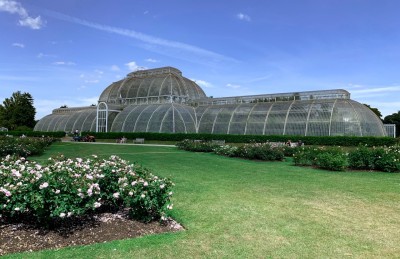
Again, you can reach Kew from London Waterloo on the train. You can also take the London Underground to Kew Gardens station on the District Line.
Other ideas for short trips from London by train and UK breaks
I hope this post has helped you plan a day trip to Hampton Court Palace.
If you’re interested in other short trips from London, or UK breaks further afield, see my other posts on this topic:

